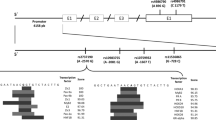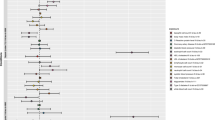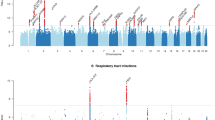Abstract
Sepsis describes a complex clinical syndrome resulting from a systemic inflammatory response to bacteria. Functional studies in animal models of sepsis have catalogued CXCL2 as a candidate gene for the development of the disease. We hypothesized that CXCL2 polymorphisms may confer susceptibility to sepsis and performed an association study using 178 severe sepsis patients and 357 population-based controls. We selected two polymorphisms from the promoter of the gene (−437A/G and −665(AC)n), and analyzed whether haplotypes or single loci were associated with disease susceptibility. An overall test of differentiation showed that haplotype distribution was not different between cases and controls (P=0.407). Likewise, −437A/G was not associated with disease susceptibility (heterozygote odds ratio (OR) 0.68 (0.47–1.03), and homozygote OR 0.86 (0.56–1.32); P=0.706). However, for the −665(AC)n, we found that the 24±1 repeat alleles were associated with susceptibility (heterozygote OR 2.82 (1.10–7.24), and homozygote OR 3.65 (1.41–9.43); P=0.0006). This association remained significant when using a multiple logistic regression analysis (OR 2.23; 95% confidence intervals (95% CI) 1.22–4.03; P=0.008) and after a genomic control adjustment (P=0.017). Although replicate studies and functional assays are needed, these results suggest that CXCL2 gene variants may contribute to the development of severe sepsis.
This is a preview of subscription content, access via your institution
Access options
Subscribe to this journal
Receive 6 digital issues and online access to articles
$119.00 per year
only $19.83 per issue
Buy this article
- Purchase on Springer Link
- Instant access to full article PDF
Prices may be subject to local taxes which are calculated during checkout


Similar content being viewed by others
References
Cohen J . The immunopathogenesis of sepsis. Nature 2002; 420: 885–891.
Villar J, Maca-Meyer N, Pérez-Méndez L, Flores C . Understanding genetic predisposition to sepsis. Crit Care 2004; 8: 180–189.
Grigoryev DN, Finigan JH, Hassoun P, Garcia JGN . Searching for gene candidates in acute lung injury. Crit Care 2004; 8: 440–447.
Chinnaiyan AM, Huber-Lang M, Kumar-Sinha C, Barrette TR, Shankar-Sinha S, Sarma VJ et al. Molecular signatures of sepsis: multiorgan gene expression profiles of systemic inflammation. Am J Pathol 2001; 159: 1199–1209.
Wolpe SD, Sherry B, Juers D, Davatelis G, Yurt RW, Cerami A . Identification and characterization of macrophage inflammatory protein 2. Proc Natl Acad Sci USA 1989; 86: 612–616.
Schramm R, Thorlacius H . Staphylococcal enterotoxin B-induced acute inflammation is inhibited by dexamethasone: important role of CXC chemokines KC and macrophage inflammatory protein 2. Infect Immun 2003; 71: 2542–2547.
Walley KR, Lukacs NW, Standiford TJ, Strieter RM, Kunkel SL . Elevated levels of macrophage inflammatory protein 2 in severe murine peritonitis increase neutrophil recruitment and mortality. Infect Immun 1997; 65: 3847–3851.
Kalyanaraman M, Heidemann SM, Sarnaik AP . Macrophage inflammatory protein-2 predicts acute lung injury in endotoxemia. J Invest Med 1998; 46: 275–278.
Ebong S, Call D, Nemzek J, Bolgos G, Newcomb D, Remick D . Immunopathologic alterations in murine models of sepsis of increasing severity. Infect Immun 1999; 67: 6603–6610.
Lomas-Neira JL, Chung CS, Wesche DE, Perl M, Ayala A . In vivo gene silencing (with siRNA) of pulmonary expression of MIP-2 versus KC results in divergent effects on hemorrhage-induced, neutrophil-mediated septic acute lung injury. J Leukocyte Biol 2005; 77: 846–853.
Lomas-Neira JL, Chung CS, Grutkoski PS, Miller EJ, Ayala A . CXCR2 inhibition suppresses hemorrhage-induced priming for acute lung injury in mice. J Leukocyte Biol 2004; 76: 58–64.
Sherwood ER, Enoh VT, Murphey ED, Lin CY . Mice depleted of CD8+ T and NK cells are resistant to injury caused by cecal ligation and puncture. Lab Invest 2004; 84: 1655–1665.
The International HapMap Consortium. The international HapMap project. Nature 2003; 426: 789–796.
Comas D, Calafell F, Benchemsi N, Helal A, Lefranc G, Stoneking M et al. Alu insertion polymorphisms in NW Africa and the Iberian Peninsula: evidence for a strong genetic boundary through the Gibraltar Straits. Hum Genet 2000; 107: 312–319.
Maca-Meyer N, Villar J, Pérez-Mendez L, Cabrera de León A, Flores C . A tale of aborigines, conquerors and slaves: Alu insertion polymorphisms and the peopling of Canary Islands. Ann Hum Genet 2004; 68: 600–605.
Bosch E, Calafell F, Comas D, Oefner PJ, Underhill PA, Bertranpetit J . High-resolution analysis of human Y-chromosome variation shows a sharp discontinuity and limited gene flow between Northwestern Africa and the Iberian Peninsula. Am J Hum Genet 2001; 68: 1019–1029.
Alonso S, Flores C, Cabrera V, Alonso A, Martín P, Albarrán C et al. The place of the Basques in the European Y-chromosome diversity landscape. Eur J Hum Genet 2005; 13: 1293–1302.
González AM, Brehm A, Pérez JA, Maca-Meyer N, Flores C, Cabrera VM . Mitochondrial DNA affinities at the Atlantic fringe of Europe. Am J Phys Anthropol 2003; 120: 391–404.
Flores C, Maca-Meyer N, Pérez JA, González AM, Larruga JM, Cabrera VM . A predominant European ancestry of paternal lineages from Canary Islands. Ann Hum Genet 2003; 67: 138–152.
Flores C, Maca-Meyer N, González AM, Oefner PJ, Shen P, Pérez JA et al. Reduced genetic structure of Iberian Peninsula revealed by Y chromosome analysis: implications for population demography. Eur J Hum Genet 2004; 12: 855–863.
Maca-Meyer N, Sánchez-Velasco P, Flores C, Larruga JM, González AM, Oterino A et al. Y chromosome and mitochondrial DNA characterization of Pasiegos, a human isolate from Cantabria (Spain). Ann Hum Genet 2003; 67: 329–339.
Levy MM, Fink MP, Marshall JC, Abraham E, Angus D, Cook D et al. 2001 SCCM/ESICM/ACCP/ATS/SIS International Sepsis Definitions Conference. Crit Care Med 2003; 31: 1250–1256.
Fallin D, Schork NJ . Accuracy of haplotype frequency estimation for biallelic loci, via the expectation-maximization algorithm for unphased diploid genotype data. Am J Hum Genet 2000; 67: 947–959.
Payseur BA, Cutter AD, Nachman MW . Searching for evidence of positive selection in the human genome using patterns of microsatellite variability. Mol Biol Evol 2002; 19: 1143–1153.
Cornuet J-M, Luikart G . Description and power analysis of two tests for detecting recent population bottlenecks from allele frequency data. Genetics 1996; 144: 2001–2014.
Wang WYS, Barratt BJ, Clayton DG, Todd JA . Genome-wide association studies: theoretical and practical concerns. Nat Rev Genet 2005; 6: 109–118.
Chakravarti A . Population genetics – making sense out of sequence. Nat Genet 1999; 21: 56–60.
Bell GI, Horita S, Karam JH . A polymorphic locus near the human insulin gene is associated with insulin-dependent diabetes mellitus. Diabetes 1984; 33: 176–183.
Altshuler D, Hirschhorn JN, Klannemark M, Lindgren CM, Vohl MC, Nemesh J et al. The common PPARg Pro12Ala polymorphism is associated with decreased risk of type 2 diabetes. Nat Genet 2000; 26: 76–80.
Tsuge M, Hamamoto R, Silva FP, Ohnishi Y, Chayama K, Kamatami M et al. A variable number of tandem repeats polymorphism in a E2F-1 binding element in the 5′ flanking region of SMYD3 is a risk factor for human cancers. Nat Genet 2005; 37: 1104–1107.
Hanlon CS, Rubinsztein DC . Arginine residues at codons112 and 158 in the apolipoprotein E gene correspond to the ancestral state in humans. Atherosclerosis 1995; 112: 85–90.
Pritchard JK, Cox NJ . The allelic architecture of human disease genes: common disease-common variant…or not? Hum Mol Genet 2002; 11: 2417–2423.
Reich DE, Cargill M, Bolk S, Ireland J, Sabeti PC, Richter DJ et al. Linkage disequilibrium in the human genome. Nature 2001; 411: 199–204.
Hao K, Li C, Rosenow C, Wong WH . Detect and adjust for population stratification in population-based association study using genomic control markers: an application of Affymetrix Genechip® Human Mapping 10K array. Eur J Hum Genet 2004; 12: 1001–1006.
Freedman ML, Reich D, Penney KL, McDonald GJ, Mignault AA, Patterson N et al. Assessing the impact of population stratification on genetic association studies. Nat Genet 2004; 36: 388–393.
Vineis P, McMichael AJ . Bias and confounding in molecular epidemiological study: special considerations. Carcinogenesis 1998; 19: 2063–2067.
Sandelin A, Wasserman WW, Lenhard B . ConSite: web-based prediction of regulatory elements using cross-species comparison. Nucleic Acids Res 2004; 32: W249–W252.
Kim DS, Han JH, Kwon HJ . NF-kappaB and c-Jun-dependent regulation of macrophage inflammatory protein-2 gene expression in response to lipopolysaccharide in RAW 264.7 cells. Mol Immunol 2003; 40: 633–643.
Hellqvist M, Mahlapuu M, Blixt A, Enerback S, Carlsson P . The human forkhead protein FREAC-2 contains two functionally redundant activation domains and interacts with TBP and TFIIB. J Biol Chem 1998; 273: 23335–23343.
Casi Y, King D, Soller M . Simple sequence repeats as a source of quantitative genetic variation. Trends Genet 1997; 13: 74–78.
Li Y-C, Korol AB, Fahima T, Nevo E . Microsatellites within genes: structure, function and evolution. Mol Biol Evol 2004; 21: 991–1007.
Dubaniewicz A, Jamieson SE, Dubaniewicz-Wybieralska M, Fakiola M, Miller EN, Blackwell JM . Association between SLC11A1 (formerly NRAMP1) and the risk of sarcoidosis in Poland. Eur J Hum Genet 2005; 13: 829–834.
Kikuchi A, Yamaya M, Suzuki S, Yasuda H, Kubo H, Nakayama K et al. Association of susceptibility to the development of lung adenocarcinoma with the heme oxygenase-1 gene promoter polymorphism. Hum Genet 2005; 116: 354–360.
Mörmann M, Rieth H, Hua TD, Assohou C, Roupelieva M, Hu SL et al. Mosaics of gene variations in the interleukin-10 gene promoter affect interleukin-10 production depending on the stimulation used. Genes Immun 2004; 5: 246–255.
Garcia-Closas M, Lubin JH . Power and sample size calculations in case–control studies of gene–environment interactions: comments on different approaches. Am J Epidemiol 1999; 149: 689–692.
Villar J, Manzano JJ, Blázquez MA, Quintana J, Lubillo S . Multiple system organ failure in acute respiratory failure. J Crit Care 1991; 6: 75–80.
Bone RC . The sepsis syndrome: definition and general approach to management. Clin Chest Med 1996; 17: 175–181.
Cabrera de León A, González DA, Méndez LI, Aguirre-Jaime A, del Cristo Rodríguez Pérez M, Coello SD et al. Leptin and altitude in the cardiovascular diseases. Obes Res 2004; 12: 1492–1498.
Mountain JL, Knight A, Jobin M, Gignoux C, Miller A, Linn AA et al. SNPSTRs: empirically derived, rapidly typed, autosomal haplotypes for inference of population history and mutational processes. Genome Res 2002; 12: 1766–1772.
Batzer MA, Deininger PL . Alu repeats and human genomic diversity. Nat Rev Genet 2002; 3: 370–379.
Watkins WS, Rogers AR, Ostler CT, Wooding S, Bamshad MJ, Brassington AM et al. Genetic variation among world populations: inferences from 100 Alu insertion polymorphisms. Genome Res 2003; 13: 1607–1618.
Barret JC, Fry B, Maller J, Daly MJ . Haploview: analysis and visualization of LD and haplotype maps. Bioinformatics 2005; 21: 263–265.
Schneider S, Roessli D, Excoffier L . Arlequin Ver. 2000: A Software for Population Genetics Data Analysis. Genetics and Biometry Laboratory, University of Geneva: Switzerland, 2000.
Guo S, Thompson E . Performing the exact test of Hardy–Weinberg proportion for multiple alleles. Biometrics 1992; 48: 361–372.
Nei M . Molecular Evolutionary Genetics. Columbia University Press: New York, 1987.
Raymond M, Rousset F . GENEPOP (ver 1.1.2): population genetics software for exact tests and ecumenicism. J Hered 1995; 86: 248–249.
Cornuet J-M, Piry S, Luikart G, Estoup A, Solignac M . New methods employing multilocus genotypes to select or exclude populations as origins of individuals. Genetics 1999; 153: 1989–2000.
Sham PC, Curtis D . Monte Carlo tests for associations between disease and alleles at high polymorphic loci. Ann Hum Genet 1995; 59: 97–105.
Reich DE, Goldstein DB . Detecting association in a case–control study while correcting for population stratification. Genet Epidemiol 2001; 20: 4–16.
Acknowledgements
This work was supported in part by grants from FUNCIS (37/02) and DGUI (209/02). CF and NM-M are FUNCIS post-doctoral fellows.
Author information
Authors and Affiliations
Consortia
Corresponding author
Additional information
Supplementary Information accompanies the paper on the Genes and Immunity website (http://www.nature.com/gene)
Supplementary information
Appendix A
Appendix A
GEN-SEP members are:
J Villara, E Espinosab, R Sangüesab, M Murosc, L Pérez-Méndeza, J Sánchez-Godoyd, M Martínd, N Maca-Meyera and C Floresa.
aResearch Institute, bDepartment of Anesthesia, cDepartment of Clinical Biochemistry and dDepartment of Intensive Care from Hospital Universitario NS e Candelaria, Tenerife, Spain.
GRECIA members are:
J Blancoa, A Muriela, V Sagradob, JC Ballesterosb, F Taboadac, G Muñizc, F Gandíad, F Bobillod, L Tamayoe, AG Labattutf, J Colladog, M Valledorh, MT Antuñah, MJ Lópezi, JJ Cortinai, T Saldañaj, A Caballeroj, T Álvarezj, M De Frutosk, J Guerral, B Álvarezm and J Sandovalm.
aMedicina Intensiva, Hospital Universitario Rio Hortega, Valladolid; bMedicina Intensiva Hospital Clínico Universitario, Salamanca; cMedicina Intensiva Hospital Central de Asturias, Oviedo; dMedicina Intensiva Hospital Clinico Universitario, Valladolid; eMedicina Intensiva Hospital Universitario Río Carrión, Palencia; fMedicina Intensiva Hospital General de Soria, Soria; gMedicina Intensiva Complejo Hospitalario de León, León; hMedicina Intensiva Hospital San Agustín, Aviles; iMedicina Intensiva Hospital General de Segovia Segovia; jMedicina Intensiva Hospital Virgen de la Concha, Zamora; kMedicina Intensiva Hospital General Yagüe Burgos; lMedicina Intensiva Hospital de Cabueñes Gijón and mMedicina Intensiva Hospital del Bierzo, Ponferrada.
Rights and permissions
About this article
Cite this article
Flores, C., Maca-Meyer, N., Pérez-Méndez, L. et al. A CXCL2 tandem repeat promoter polymorphism is associated with susceptibility to severe sepsis in the Spanish population. Genes Immun 7, 141–149 (2006). https://doi.org/10.1038/sj.gene.6364280
Received:
Revised:
Accepted:
Published:
Issue Date:
DOI: https://doi.org/10.1038/sj.gene.6364280
Keywords
This article is cited by
-
Impact of genetic polymorphisms determining leukocyte/neutrophil count on chemotherapy toxicity
The Pharmacogenomics Journal (2018)
-
Ethical considerations in the collection of genetic data from critically ill patients: What do published studies reveal about potential directions for empirical ethics research?
The Pharmacogenomics Journal (2010)
-
Angiotensin-converting enzyme insertion/deletion polymorphism is not associated with susceptibility and outcome in sepsis and acute respiratory distress syndrome
Intensive Care Medicine (2008)



